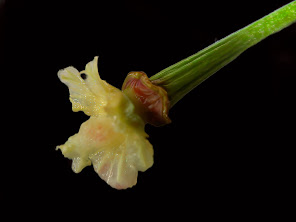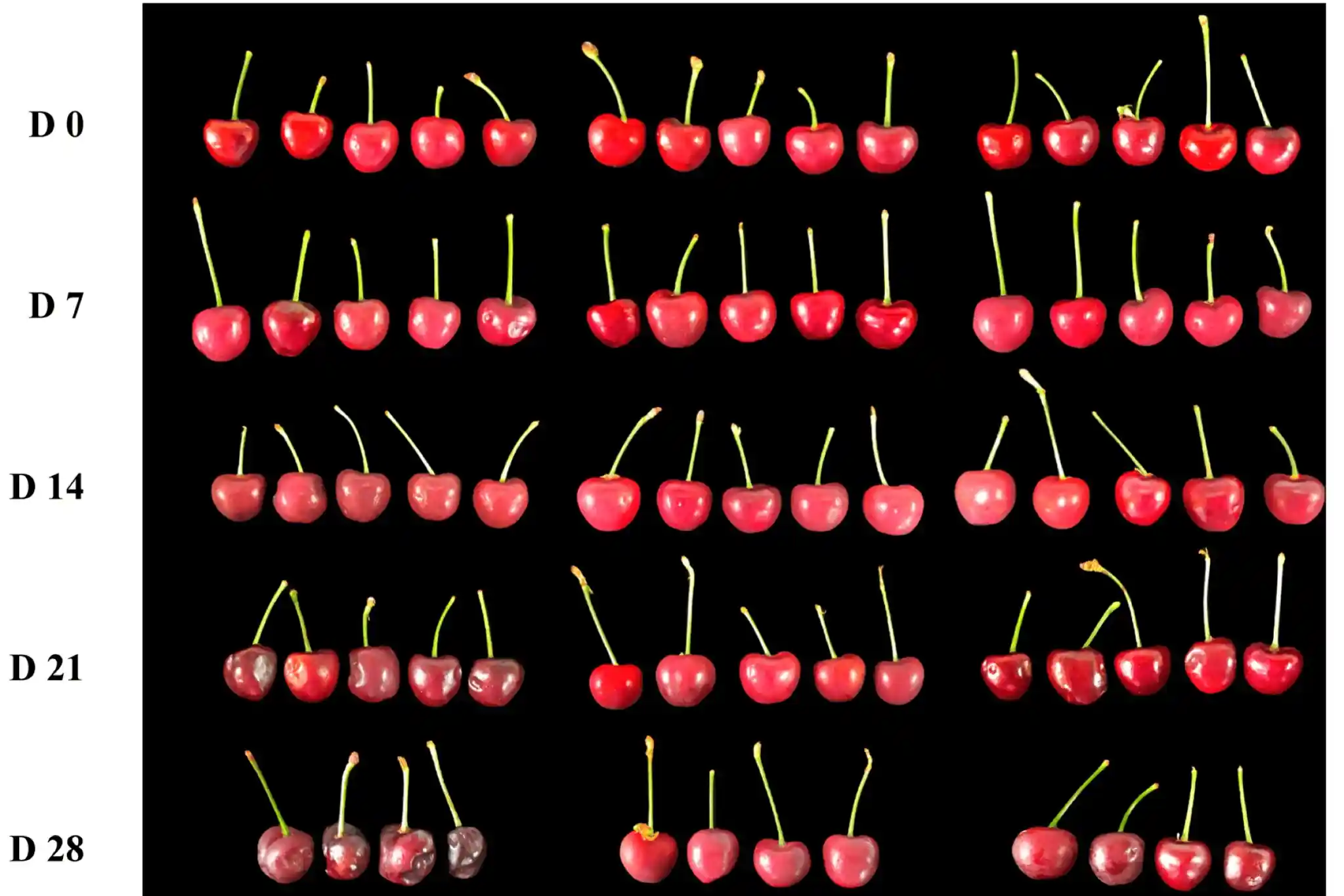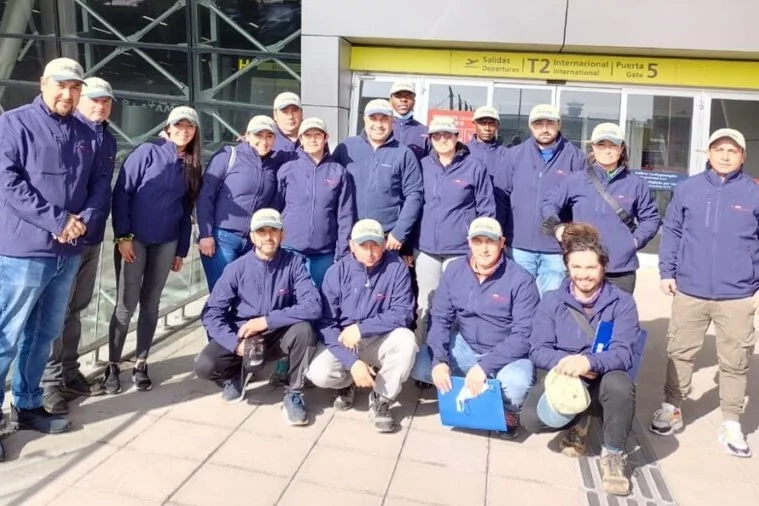The stalk, also known as the peduncle, is the structure that connects the fruit to the branches of the cherry tree. It plays a key role in supporting the fruit and facilitating the transport of nutrients and water between the fruit and the tree. The pedicel consists of vascular tissues, including the xylem and phloem, which are responsible for transporting water, minerals and sugars. It also contains other cell types, such as sclerenchyma fibres and parenchyma cells.
The surface of the pedicel is covered by a cuticular membrane and wax, which act as barriers against water loss through transpiration. The epidermis and cuticular layer of the pedicels are thinner than the fruit itself, which makes them more sensitive to water and carbon dioxide loss (Smith & Whiting, 2010a). The stomata, small openings on the surface of the stalk, also play a role in regulating water loss (Hewitt et al., 2021).
The appearance of pedicels significantly influences consumers' perception of cherry quality (Y. Zhao et al., 2013). Consumers tend to prefer cherries with green and turgid pedicels, as they perceive them to be of higher quality. Wilted and brown pedicels are associated with post-harvest water loss, loss of membrane integrity and oxidation of phenolics, which can have a negative impact on fruit quality and market value (Knoche et al., 2015; H. Zhao et al., 2021).
These changes in pedicel appearance indicate inadequate harvesting and storage conditions or an extended storage period, resulting in reduced value at the point of sale (Brüggenwirth & Knoche, 2015). Prevention of pedicel desiccation is crucial to maintain fruit quality and prolong the potential marketing period.
Pedicel transpiration can be minimised by reducing the driving force (difference in water vapour concentration) during post-harvest handling and storage (Athoo et al., 2015).
Understanding the mechanisms and pathways of water loss through the pedicel can help develop strategies to minimise pedicel dehydration and preserve the post-harvest quality of sweet cherry fruits (Athoo et al., 2015; Brüggenwirth & Knoche, 2015).
One approach is to use hydro-cooling in the field, whereby freshly harvested cherries are pre-cooled. This technique has been shown to improve pedicel appearance and reduce visual dehydration, resulting in greener and turgid pedicels (Zoffoli, 2022).
Cherries are very tolerant to low temperatures; recommended storage conditions to keep the fruit fresh and the pedicels green and turgid are temperatures between -0.5 and 0°C and relative humidity between 90-95% (Alonso & Alique, 2006). Furthermore, the use of modified atmosphere packaging (MAP) during storage can help maintain the quality of cherries, including the stalk.
The use of modified atmosphere pouches has proven to be the best strategy to extend the shelf life of cherries by controlling oxygen and carbon dioxide levels within the package (Alonso & Alique, 2006; Quero-García et al., 2022).
The process of pedicel dehydration in cherry fruits involves transpiration, osmotic dehydration and water flow through the xylem. It has been hypothesised that pedicel transpiration in an unsaturated atmosphere is the main mechanism of pedicel dehydration, leading to pedicel browning and wilting.
However, recent research suggests that osmotic dehydration may also play a role in pedicel dehydration, independent of transpiration (Knoche et al., 2015).
Pedicel transpiration is a physical process governed by Fick's law of diffusion, with the cuticle and wax representing the main barriers that limit the rate of transpiration. The permeability of the pedicel surface exceeds that of the fruit due to a more permeable cuticle and higher stomatal density.
Considerable variability in transpiration rates between different cherry cultivars has been observed and the stomata play a key role in controlling pedicel transpiration by adapting to different environmental conditions. On the other hand, the fruit exerts a significant influence on pedicel transpiration, indicating an important interaction between both elements of the plant, linked to the vascular system, which is essential for maintaining water balance and preserving cherry quality (Athoo et al., 2015).
Osmotic dehydration has been identified as a key factor in pedicel wrinkling and deterioration during storage: pedicels attached to the fruit experience a reduction in water content when the fruit absorbs water from the pedicel under non-transpiration conditions, leading to an increase in the concentration of solutes in the pedicel and, consequently, its osmolarity (Knoche et al., 2015).
Pedicel conductance, or the ability of water to flow through the pedicel, is influenced by factors such as pedicel length and developmental stage, as well as two key factors: internal cell pressure and temperature. Internal cell pressure, also known as turgor pressure, plays an important role in the movement of water through plant tissues, generating forces that guide the flow of water.
On the other hand, temperature also influences the viscosity of water and thus can affect the ease with which water moves through the xylem vessels in the stalks (Brüggenwirth & Knoche, 2015).
The process of pedicel abscission involves the formation of an abscission zone at the point of separation between the pedicel and the fruit. This zone consists of weakened layers of parenchyma cells that decompose through the conversion of pectic acid to pectin and the accumulation of lignin deposits (Smith & Whiting, 2010b; Y. Zhao et al., 2013).
In this way, a naturally thickened separation tissue develops, which hydraulically separates the fruit body and pedicel, increasing the water vapour resistance and thus the hydraulic conductivity of the fruit to the pedicel (Linke et al., 2010). Therefore, the abscission process is also influenced by these water relations.
When the fruit dehydrates, the water conduction system can collapse, reducing hydraulic conductivity and preventing further water translocation. Desiccation of the pedicel tissue due to water loss can lead to changes in pedicel colour and damage to the photosynthetic apparatus (Linke et al., 2010b).
The abscission process between pedicel and fruit involves a complex interaction between ethylene- and auxin-associated pathways. High auxin levels delay abscission, while a decrease in auxin levels increases the up-regulation potential of ethylene, leading to cell wall degradation and ultimately to cell death (Linke et al., 2010b).
Ethylene binds to receptors on cells in the abscission zone, initiating signal transduction pathways that lead to the activation of transcription factors that respond to ethylene. The molecular and genetic mechanisms involved in the pedicel-fruit abscission process include differential expression of genes related to cell wall degradation, lignin synthesis, hormonal regulation (such as the response to ethylene) and activation of specific metabolic pathways.
Specific genes and enriched ontology terms related to the abscission process of different sweet cherry cultivars were identified, suggesting that each cultivar may have unique genetic mechanisms and biological processes that influence its abscission capacity, highlighting the genetic diversity and complexity of abscission regulation in different sweet cherry varieties (Hewitt et al., 2021).
Ethephon, a plant growth regulator, can induce abscission by triggering the expression of genes involved in cell division (Smith & Whiting, 2010b). Therefore, different cherry cultivars have been classified according to their reaction to ethephon application and their response to pedicel and fruit retention force (PFRF) in order to identify the most suitable varieties for mechanical or manual harvesting (Y. Zhao et al., 2013).
 Stalk with high PRFR.
Stalk with high PRFR.
Three categories of genotypes were identified in relation to their suitability for mechanical harvesting: 'non-inducible' genotypes that do not develop a sufficiently low pedicel-fruit retention force for mechanised harvesting (such as 'Chelan'), 'inducible' genotypes that can achieve a sufficiently low pedicel-fruit retention force with an ethephon treatment (such as 'Bing'), and genotypes with the characteristic of 'self-abscission' that naturally develop a pedicel-fruit abscission zone suitable for mechanical harvesting (Smith & Whiting, 2010b).
 Stalk with low PRFR.
Stalk with low PRFR.
On the other hand, it has been observed that 1-MCP treatments regulate the expression of genes associated with chlorophyll degradation in the cherry pedicel, helping to stabilise the cell membrane by blocking ethylene perception, thus preventing senescence and chlorophyll degradation in the pedicel (H. Zhao et al., 2021).
A detailed understanding of the pedicel abscission process in sweet cherries is crucial to optimise post-harvest handling practices and improve fruit quality. By manipulating environmental conditions and hormone treatments, pedicel deterioration can be reduced and fruit shelf life extended.
In addition, this knowledge makes it possible to select specific varieties with desirable characteristics for different harvest and marketing purposes. Furthermore, understanding the factors that influence the hydraulic conductivity and water balance between stalk and fruit is crucial to prevent quality loss due to dehydration and water stress.
With this holistic approach, more effective strategies can be developed to maintain the quality of sweet cherries, meeting both growers' needs and consumers' expectations.
Source: El Mundo de las Cerezas
Images: El Mundo de las Cerezas
J.A.Sanchez
Cherry Times - All rights reserved












